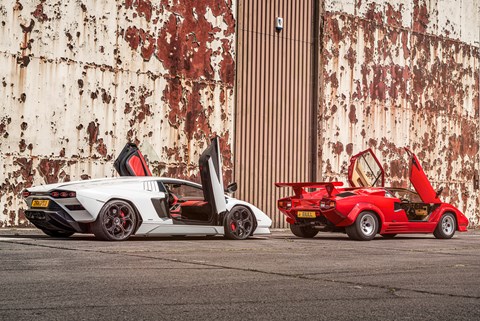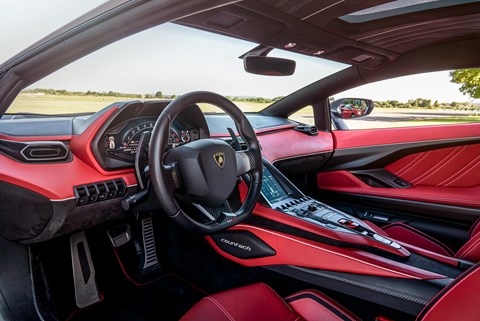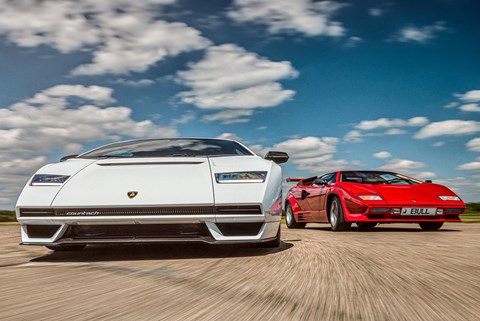► It’s Lamborghini Countach vs Countach
► We test LPI 800-4 vs original 5000 QV
► Join us as we go premier-league bull-fighting
Like all the best stories, there’s more than one version and no one can quite agree which one’s true. The most popular version of how the Lamborghini Countach got its name is that a technician saw the original show car for the first time in all its impossibly low, impossibly wide origami glory as it was being hurriedly prepped for its debut at the ’71 Geneva show and blurted Countach! It’s an exclamation in the local Piedmontese dialect for which there’s no direct translation in English. The Lamborghini Cor Blimey wouldn’t really have the same ring to it.
True or not, the new supercar codenamed LP500 didn’t yet have a name, and this one stuck. And it is a great name. Countach! Then the name returned in 2022 on the Aventador-based Lamborghini Countach LPI 800-4. Only 112 were to be built, at £1.7m each, and all sold in the blink of an eye.
Seeing both of these cars together for the first time, Countach is as good an exclamation as any. As the scissor doors on both cars are lofted upwards, beckoning us to go for a drive, the English language is falling a bit short at this moment.

The red car isn’t just any Countach – it’s a 5000 Quattrovalvole from 1988, considered by Countach cognoscenti to be the ultimate of its kind: the optimum blend of power (with 455bhp from its 5.2-litre V12), handling (with huge Pirelli P7s under the wraparound arches) and style (with less fussy design than the Anniversario that rounded out the latter parts of the Countach’s 14-year production run). Only 15 right-hand-drive QVs were built, this car’s owners Tadek and Verna Lipinski tell me, and only 12 remain.
If the show car that inspired that original expletive was strikingly pure, this QV is the Countach at its most hedonistic, with those wide arches, telephone-dial wheels and famously unaerodynamic rear wing all present.
The new Countach’s styling sits somewhere between the two stools. It’s an arrestingly clean shape, your eye able to trace one seemingly continuous line from stem to stern. And it’s a strikingly attractive one in person, perhaps more so than it appears in photos. When Countach II was first revealed in 2021, to celebrate the 50th anniversary of that 1971 show car, it was to a mixture of enthusiastic applause from some quarters and more muted ‘doesn’t live up to the original’ murmurs elsewhere. Like George Lazenby following Sean Connery as Bond, perhaps it was always going to meet with resistance. But here and now, in three dimensions and sunshine, it looks sensational. It’s packed with well-read quotes from the original’s design: the pentagonal rear wheelarch line (echoed in the front arch too); the supersized NACA duct in profile; the glazing in the roof echoing the original LP400 Countach’s periscope system (to get around poor rear visibility). And equally it’s not a slavish copy, with an identity all of its own.
Tadek likes the sequel’s design: ‘It’s very elegant and clean – some supercars are OTT, this is more restrained.’ Hats off to Mitja Borkert and his design team. The difference in size between the two cars is obvious: the new car’s 20- and 21-inch wheels (with rubber-band sidewalls) are the height of the entire wheelarches on the classic, on its tall-shouldered 15-inch Pirelli P7s.

The new car’s design is drawn around the hard points of the Sián/Aventador architecture, and it shares its 803bhp hybridised powertrain with the Sián: the 769bhp 6.5-litre V12 is subsidised by a 34bhp 48-volt e-motor, with a supercapacitor rather than a conventional li-ion battery.
Mind you, a youthful group of workers happening upon our test walk straight past the LPI 800-4 as if it’s invisible, and make a beeline for the LP 5000 S QV. They’re in raptures when its headlights flick up. Modern regulatory standards have made pop-ups a near- impossibility to be designed into the new car, although its neatly integrated quadrilateral headlights emphasise its smooth, restrained form. I have an overwhelming desire to drive the original Countach first. I played with a Matchbox model incessantly as a kid. I had the poster. Its designer Marcello Gandini is one of my heroes.
And I’m also fully prepared for it to be rubbish. I’ve read all the stories: how you need two feet to press the clutch pedal, how you can’t see anything behind you, how it cooks you alive in hot weather and won’t start in cold, how the driving position requires the arms of an orangutan and the legs of a dachshund to reach the controls… and I couldn’t care less. I’m more excited about driving this than almost any car I’ve had the dumb luck to sit in for CAR. Tadek talks me through the easiest way to climb in – bum first, feet follow afterwards – and the controls. The pedals are seriously offset: top-hinged clutch and brake and a tiny, floor-hinged throttle, tucked away down to the right. Given an exploratory press, it feels about as heavy as the clutch. But one leg is enough. The steering wheel is just perfect: not too big, not too small. The infamous long- arm, short-leg driving position is nowhere near as pronounced as the stories suggest and the curving seats – like thin scoops of caramel ice cream with square indents – are far more supportive than they look.

Ahead, the dash is so low I need to duck in the seat to see the gauges clearly. Behind, the view is full of the wing and engine cover, leaving an aperture shaped like a square bracket on its side. ‘You can see blue flashing lights and that’s all you need,’ winks Tadek. He also cautions that second gear’s inaccessible from cold, but the V12 and its transmission – in which drive goes forwards into the gearbox between the seats, then backwards through the sump to the diff – are already warmed through and ready to go. The engine fires without any extra persuasion from the throttle and settles into a clean idle. First gear slots with a definite click. Deep breath: let’s go.
Though weighty, the clutch is friendly and there’s no danger of stalling. It doesn’t take many revs for the 12 cylinders to begin to sing their symphony, at a lusty volume. Conversation isn’t easy, even at low speeds. ‘It has a radio – an original Alpine unit – but we never listen to it,’ Tadek says. ‘The music comes from the engine.’ The revcounter has a yellow section at 7000 and turns red at 7500. I’m shifting up between 6000 and 6500 and the sound is glorious. The speedo goes to 200mph. (The QV’s on-paper engine speed at close to 8000rpm is 195mph.) ‘It’s rock-solid at 180mph,’ Tadek says, casually. ‘When we’ve driven to Italy and back the throttle was down all the way. The car doesn’t enjoy being driven slowly. It’s happiest at 60mph and above.’
That’s certainly true at this tight, compact test track but once I’m used to the sheer weight of the unassisted steering, which starts out heavy and then gets more so as a corner progresses, the Countach feels genuinely wieldy. The suspension is firm, perhaps to deal with the sheer weight of the powertrain, and you feel the expansion joints keenly. But there is compliance too, and more bodyroll than a modern supercar. With the big V12 behind you, the weight distribution is very much to the rear: get on the throttle too early and it’ll understeer, but once you’ve aligned your inputs with the car’s natural rhythm and invoke a little weight transfer it arcs through corners sweetly. I don’t dare try inciting any serious oversteer but there is a fundamentally agile car at the heart of the Countach.
‘You have to concentrate fully, at all speeds,’ Tadek enthuses. ‘It’s definitely a real driver’s car.’ I couldn’t agree more; I’m completely absorbed, and transfixed. The gearchange needs concentration too, requiring a firm hand, but gives you an equally definite engagement in return as you slot the lever through its open gate. There’s a dead spot at the top of the brake pedal’s travel, and a bigger one at the top of the throttle’s. Pick-up is not totally clean and linear like in a modern fuel-injected, digital-throttle-map car.
That’s fine by me. I pull to a halt in the pitlane, sweaty and red in the face – the air-con is as ineffectual as the stories suggest – and giddy with excitement. Not just from the faint smell of petrol fumes, either. Never meet your heroes? What a load of bull.

How can the successor possibly match that experience? One way to find out. The Aventador architecture is evident when you inelegantly clamber in. The seats’ square-section stitching echoes the original but the rest of the cabin is very similar to that of the Aventador Ultimae we drove in the May issue. There’s a lovely touch in the form of a glass panel that cuts into the roof, a nod to the original Periscopio Countach, in photochromic glass that brightens and darkens at the touch of a switch. The driving position is awkward; I am not the tallest member of the CAR team at 5ft 11in but my head is nearly brushing the ceiling and I need to cant the seat backwards a touch.
Getting underway is as simple as pulling a paddle; the automated manual paddleshift is ponderously slow in comparison with dual- clutch supercars but smoother than I remember in the Ultimae, the modest hybrid assistance rounding its most jarring edges. That is, until you flick the drive mode switch on the steering wheel to Corsa, at which point it becomes really quite savage, slamming each new gear home. The adaptive suspension too becomes brutally firm in Corsa, especially on rebound, although even in the softest Strada setting the new Countach finds bumps that the classic car didn’t – blame those rubber-band tyres.
The grip they generate is remarkable, however. Front-end grip feels off-the-scale after driving the QV – you can fairly throw the new Countach at a corner, and around this short, technical circuit it’s a really quite physical animal to drive at speed. You hang on over the bumps, rodeo-style, g-force from the grippier tyres pawing at your core. Despite the big mechanical grip it can be provoked into slides, particularly in middling Sport mode, although you’re very aware you’re carrying a lot of momentum when it does go.
And you don’t get much of a break on the straight, because the LPI 800-4 simply devours it. This is a very fast car. It too has a magical V12 soundtrack although it’s a thinner, more metallic note than that of the older car, which has a deeper, richer sound with more body to it. But the sheer performance the new car summons – it feels like the Countach species has graduated from supercar to hypercar.

Possessing such gargantuan performance feels appropriate for a modern Countach, especially when the original Countach always possessed phenomenal figures in period (even if some of them were reputedly the result of a bit of creative accounting with the stopwatch and dyno figures, which feels all part of the charm to me; there was something likeably roguish about ’70s/’80s-era Lamborghini).
The second-life Countach might be a tribute act rather than the original artist but it’s a wonderful one. It doesn’t lessen the Countach’s legacy and carries so much of the same spirit. I love it, and Tadek and Verna are enamoured with it too. Tadek even posits that it’s the only modern supercar he’s experienced that he would consider replacing the QV with – but all 112 LPI 800-4s are very much sold out.
To have experienced one, together with the Quattrovalvole, and to discover that it’s every bit as wonderful as I dreamed it would be playing with that Matchbox model all those years ago – well, there’s only one word I can think of to describe it…
With huge thanks to Countach Quattrovalvole owners Tadek and Verna Lipinski 🙌